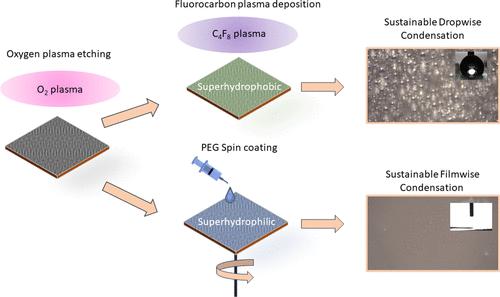当前位置:
X-MOL 学术
›
Ind. Eng. Chem. Res.
›
论文详情
Our official English website, www.x-mol.net, welcomes your
feedback! (Note: you will need to create a separate account there.)
Durable Surfaces of Both Wettability Extremes with Stable Dew Harvesting Performance During Liquid–Vapor-Phase Transitions
Industrial & Engineering Chemistry Research ( IF 3.8 ) Pub Date : 2024-11-20 , DOI: 10.1021/acs.iecr.4c02374 Dimitrios Nioras, Evangelos Gogolides, Kosmas Ellinas
Industrial & Engineering Chemistry Research ( IF 3.8 ) Pub Date : 2024-11-20 , DOI: 10.1021/acs.iecr.4c02374 Dimitrios Nioras, Evangelos Gogolides, Kosmas Ellinas

|
Leveraging micro- and nanoengineering, functional surfaces revolutionize interactions between materials and their environment, leading to a new era of advanced materials. Functional surfaces are capable of providing a wide range of applications, i.e., antifogging, anti-icing, and antiwetting. These surfaces exhibit remarkable adaptability, improving the performance of microfluidic devices, sensors, and MEMS. Superhydrophobic and superhydrophilic surfaces represent the pinnacle of water repellence and attraction, crucial for enhancing applications like dew water harvesting and condensation-related applications, i.e., heat exchangers. To achieve surfaces with such remarkable properties, several delicate processes have been developed, and today’s request is to improve their durability, repeatability, and reusability. In this work, we present a fabrication process for superhydrophilic and superhydrophobic surfaces based on oxygen plasma micro- and nanotexturing, followed by a thin coating deposition of poly(ethylene glycol) (PEG) for superhydrophilicity and plasma deposition of C4F8 for superhydrophobicity. It is demonstrated that the surfaces of both wetting extremes exhibit remarkable stability in their wetting properties, maintaining stable water static contact angles (WSCAs) of 161° (for the 9 min plasma micronanotextured superhydrophobic surface) or 0° (for the 9 min plasma micronanotextured and PEG-coated superhydrophilic surface) for more than 4 months of storage in ambient conditions. Superhydrophilic surfaces, which are more prone to wetting property deterioration, are additionally tested using water immersion tests for 14 days, and it is shown that the use of the PEG coating on plasma micronanotextured surfaces enhances the superhydrophilic property stability (WSCA: 25° compared to 63° for the uncoated plasma-textured surface). Finally, the surfaces are probed by dew water harvesting experiments in which no significant performance deterioration is observed and water collection rate (WCR) reduction during aging (after storage) is 20% in the case of the superhydrophobic and less than 5% for the superhydrophilic PEG-coated surface. More vulnerable to wetting, superhydrophilic surfaces are also tested in terms of reusability (i.e., after multiple uses of the same surfaces), and it is found that the WCR decrease is less than 17% (for the 6 min plasma micronanotextured and PEG-coated surfaces).
中文翻译:

两种极端润湿性的耐用表面,在液-气相转变期间具有稳定的露水收集性能
利用微纳米工程,功能性表面彻底改变了材料与其环境之间的相互作用,开创了先进材料的新时代。功能性表面能够提供广泛的应用,即防雾、防冰和防润湿。这些表面表现出显着的适应性,提高了微流体设备、传感器和 MEMS 的性能。超疏水和超亲水表面代表了防水和吸引的顶峰,对于增强露水收集和冷凝相关应用(即热交换器)等应用至关重要。为了获得具有如此卓越性能的表面,已经开发了几种精细的工艺,今天的要求是提高它们的耐用性、可重复性和可重用性。在这项工作中,我们提出了一种基于氧等离子体微细和纳米纹理的超亲水和超疏水表面的制造工艺,然后是聚乙二醇 (PEG) 的薄涂层沉积以实现超亲水性,等离子体沉积 C4F8 以实现超疏水性。结果表明,两种润湿极端的表面在其润湿性能方面都表现出显着的稳定性,保持稳定的水静接触角 (WSCA) 为 161°(对于 9 分钟等离子体微纳米纹理超疏水表面)或 0°(对于 9 分钟等离子体微纳米纹理和 PEG 涂层超亲水表面)在环境条件下储存超过 4 个月。 超亲水表面更容易变湿,另外使用 14 天的浸水测试进行了测试,结果表明,在等离子体微纳米纹理表面使用 PEG 涂层增强了超亲水性能稳定性(WSCA:25°,而未涂层等离子体纹理表面为 63°)。最后,通过露水收集实验探测表面,其中没有观察到明显的性能恶化,在超疏水的情况下,老化(储存后)的集水率 (WCR) 降低为 20%,超亲水性 PEG 涂层表面的集水率 (WCR) 降低不到 5%。更易受润湿的超亲水表面也进行了可重用性测试(即,在多次使用相同表面后),发现 WCR 降低不到 17%(对于 6 分钟等离子体微纳米纹理和 PEG 涂层表面)。
更新日期:2024-11-20
中文翻译:

两种极端润湿性的耐用表面,在液-气相转变期间具有稳定的露水收集性能
利用微纳米工程,功能性表面彻底改变了材料与其环境之间的相互作用,开创了先进材料的新时代。功能性表面能够提供广泛的应用,即防雾、防冰和防润湿。这些表面表现出显着的适应性,提高了微流体设备、传感器和 MEMS 的性能。超疏水和超亲水表面代表了防水和吸引的顶峰,对于增强露水收集和冷凝相关应用(即热交换器)等应用至关重要。为了获得具有如此卓越性能的表面,已经开发了几种精细的工艺,今天的要求是提高它们的耐用性、可重复性和可重用性。在这项工作中,我们提出了一种基于氧等离子体微细和纳米纹理的超亲水和超疏水表面的制造工艺,然后是聚乙二醇 (PEG) 的薄涂层沉积以实现超亲水性,等离子体沉积 C4F8 以实现超疏水性。结果表明,两种润湿极端的表面在其润湿性能方面都表现出显着的稳定性,保持稳定的水静接触角 (WSCA) 为 161°(对于 9 分钟等离子体微纳米纹理超疏水表面)或 0°(对于 9 分钟等离子体微纳米纹理和 PEG 涂层超亲水表面)在环境条件下储存超过 4 个月。 超亲水表面更容易变湿,另外使用 14 天的浸水测试进行了测试,结果表明,在等离子体微纳米纹理表面使用 PEG 涂层增强了超亲水性能稳定性(WSCA:25°,而未涂层等离子体纹理表面为 63°)。最后,通过露水收集实验探测表面,其中没有观察到明显的性能恶化,在超疏水的情况下,老化(储存后)的集水率 (WCR) 降低为 20%,超亲水性 PEG 涂层表面的集水率 (WCR) 降低不到 5%。更易受润湿的超亲水表面也进行了可重用性测试(即,在多次使用相同表面后),发现 WCR 降低不到 17%(对于 6 分钟等离子体微纳米纹理和 PEG 涂层表面)。

































 京公网安备 11010802027423号
京公网安备 11010802027423号